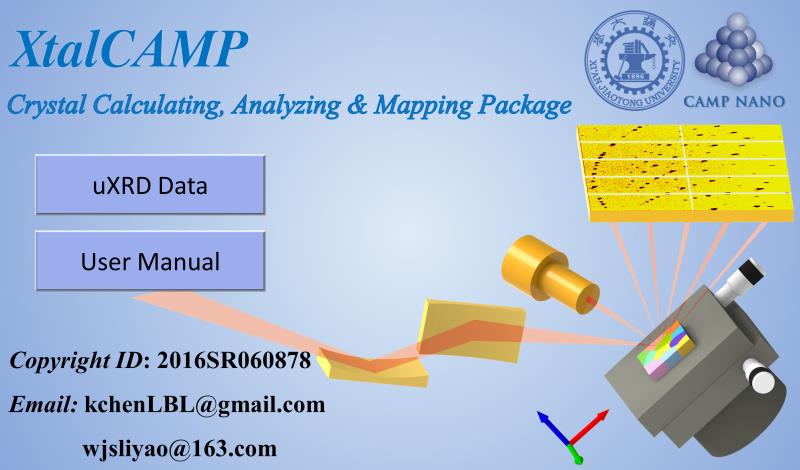
Introduction
Crystal Computing and Mapping Program (XtalCAMP) is a custom-developed comprehensive software for the in-depth analysis of the outputs of μXRD data indexation, which incorporates a variety of easy-to-use features, including diffraction intensity study, basic 2D map plotting, crystal orientation and misorientation analysis, grain boundary characterization, strain/stress distribution visualization and other useful tools. The input information is generated from most of the mainstream Laue indexation software packages such as XMAS, LaueGo, and LaueTools.
XtalCAMP is coded through the MATLAB graphical user interface module and can be executed on MATLAB R2014b and higher versions installed on Windows 7 and 10 operating systems (32 bit or 64 bit). It has been registered at the Copyright Protection Centre of China (Registration Nos. 2015SR263332, 2016SR060878).
XtalCAMP is constantly updated and the latest version is posted on this webpage.
How to Download and use XtalCAMP
XtalCAMP can be downloaded by clicking on the link below. Follow the procedure:
1. Download
 XtalCAMP_v2.4.zip for Windows operating systems.
XtalCAMP_v2.4.zip for Windows operating systems.
2. After downloading, unzip XtalCAMP.zip into a directory (e.g. C:\XtalCAMP, it would be better not use any Chinese character in the directory name).
3. Start Matlab with a version of R2014b or higher. Set the work directory to the directory you unzipped the XtalCAMP, and then input “setup_xtalcamp” on the Command Window and press enter. Then you will see “XtalCAMP Setup Successfully!”
4. Input "xtalcamp" in Command Window to run XtalCAMP.
5. For the first run, you will get a serial code. Please send it to wjsliyao@163.com or kchenLBL@gmail.com to obtain the registration code.
6. Click "uXRD data" for data analysis, and "User Manual" for help. Basic features are described in J. Appl. Cryst. (under review).
Toolkits
1. A toolkit for editing XMAS *.seq files.
(1) Download
 edit_seq.zip and unzip it into a directory (e.g. C:\XtalCAMP);
edit_seq.zip and unzip it into a directory (e.g. C:\XtalCAMP);
(2) Open Matlab and set the work directory to the directory you unzipped the edit_seq.zip;
(3) Then input “edit_seq” on the Command Window and press enter.
(4) User can edit the image number, stage coordinates, combine multiple *.seq files and output the modified *.seq file.
Contact information
Yao Li1,2, Kai Chen1
1. Center for Advancing Materials Performance from the Nanoscale (CAMP-Nano), State Key Laboratory for Mechanical Behavior of Materials, Xi’an Jiaotong University, Xi’an, Shaanxi 710049, P.R. China
2. School of Materials Science and Engineering, Chang’an University, Xi’an, Shaanxi 710064, P.R. China
kchenLBL@gmail.com
wjsliyao@163.com
Acknowledgements
This work was supported by the National Natural Science Foundation of China (No. 51901026, 91860109, 51927801) and the National Key Research and Development Program of China (No. 2016YFB0700404).
Last edited on April 3, 2020.

